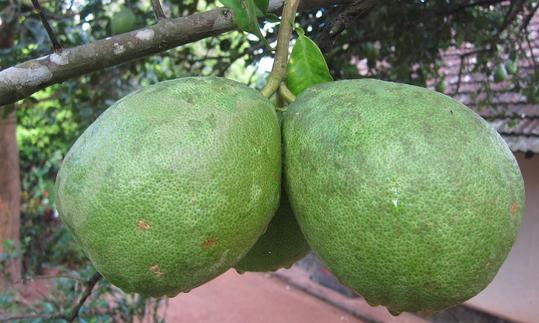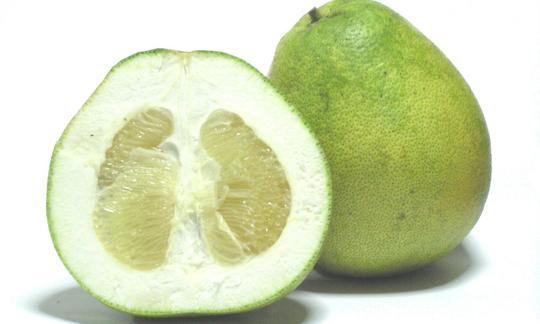The grapefruit ( pumelo , not pomelo), the origin of many citrus species, is particularly rich in vitamin C. The pulp can be eaten raw or cooked. As with grapefruit and pomelo , the ingredients of the grapefruit can interact with certain medicines.
Use in the kitchen:
Since the skin of the grapefruit is very firm and bitter between the segments, it is removed before consumption and enjoyed filleted. The pure flesh of the grapefruit tastes sweet and sour with a bitter note. Grapefruits are a good exotic ingredient in leaf salads. In fruit salads they go very well with apples and pears, but not with other citrus fruits. If you eat them as a snack between meals, adding a sweetener (maple syrup or honey) helps to mask the bitter taste. The flesh can be used to make jam. The juice is used to flavor sauces, dressings and drinks.
| Not only vegans or vegetarians should read this: Vegans often eat unhealthily. Avoidable nutritional mistakes . |
Purchasing:
In western parts of Europe, pomelo is rarely found in supermarkets. It is often mistakenly sold under the name grapefruit. The fleshy fruit (hesperidium) is slightly flattened on the top and bottom, round or pear-shaped. The thick outer skin is yellow or yellow-green in color. Removing the outer skin, which is about 1.5 cm thick, works like an orange; it comes off easily after cutting. The color of the flesh ranges from whitish to pink to red.
There are many varieties and hybrids of grapefruit. The following cultivated forms of Citrus maxima are available on the European market: Jaffa Pumelo (green-yellow on the outside, red flesh on the inside, from Israel), Honey (belongs to the Thai group, yellow on the outside, yellowish on the inside, tastes sweet, from China), Goliath (very large and similar to Honey, from Israel), Pink (deep red flesh, sweet with a fine acidity, from South Africa).
Found in the wild:
Often referred to as Citrus grandis, it is thought to still be found in the wild on the upper Salwen River in Assam (East India). In Siam (Thailand) it is found on saline, brackish soils. 7
Storage:
If stored in a cool place, the grapefruit will remain aromatic for 2 - 3 months. At room temperature, it can be kept for several weeks.
Ingredients:
Grapefruits have very few calories. Grapefruits consist of 90% water, around 10% carbohydrates, 0.7% protein and 0.04% fat. The high vitamin C content makes them particularly popular in cold seasons. The minerals they contain include iron , magnesium , phosphorus , sodium and zinc. Grapefruits also contain vitamins from the B group ( B 1 , B 2 , B 3 and B 6 ).
Health aspects:
The bitter substances contained in grapefruit are good for digestion. They stimulate gastric juice and fat digestion and ensure an improved feeling of satiety. Naringin and its breakdown products break down cholesterol and have a positive effect on blood sugar. This bitter substance, which is present in citrus fruits such as pomelos, grapefruits and pomelo, also has a blood pressure lowering effect. You should never use blood pressure lowering medication and grapefruit together.
If you measure your blood pressure several times a day (especially before falling asleep and when you wake up, before you get out of bed), you may be able to keep your blood pressure in the normal range for a long time with the fruit. You should discuss the values with a doctor from time to time. In the case of essential high blood pressure, a vegan diet can work wonders anyway!
Grapefruit also plays a role in cancer research. Regular consumption of grapefruit reduces the risk of cancer due to its high vitamin C content. Vitamin C binds free radicals in the body and neutralizes them.
Dangers / Intolerances:
Certain polyphenols in grapefruit, such as naringenin (a breakdown product of naringin), inhibit the metabolism of various substances (e.g. cytochromes) in the liver. This affects the effects and side effects of drugs and medications. 3 Since this bitter substance lowers blood pressure, grapefruits should be avoided when taking blood pressure-lowering medications. These interactions also occur when consuming grapefruits, pomelos and bitter oranges (bitter oranges), but not with oranges. 4,6
Interactions can occur with the following medications: antidepressants, heart medications, antibiotics, immunosuppressants, pain medications, sexual enhancers, blood pressure lowering drugs, cancer drugs and the contraceptive pill. Many medication instructions do not warn of possible interactions. In the USA, before new drugs are approved, they are checked for interactions with grapefruits. Experts advise patients who take medications around 8:00 a.m. to avoid consuming grapefruits until noon. 5,6
Occurrence:
Grapefruits originate from tropical Southeast Asia. They are the oldest known citrus fruits and came to China from the Malaysian region. Today they are mainly grown in Japan, Taiwan, Indonesia, Thailand, Malaysia, China, Israel, Brazil and the southern USA.
Cultivation, harvest:
Since grapefruits are particularly susceptible to foot rot, they must be planted in very well-drained soil. Grown from cuttings, the pumelo flowers in the first year. These trees only produce fruit when they reach a certain size. In commercial cultivation, grapefruit trees are grafted onto strong-growing rootstocks (e.g. rough lemon, bitter orange, Sun Chuhu Sha mandarin, citrumelo, etc.). This results in a high harvest after about 3 years. The grapefruit trees are medium-sized, up to about 15 m tall, with a spreading crown. There are thorns in the leaf axils of the evergreen trees. The leathery leaves of the grapefruit are larger than those of other citrus plants. In comparison to grapefruit, the leaves are hairy on the underside. The harvest window is from November to July.
Danger of confusion:
Externally, the pomelo looks very similar to the pomelo in size and shape. However, pomelo tastes much more bitter and the skin between the segments is much harder and almost inedible. Since the pomelo is little known in the European trade, it is often confused with grapefruit because of its name (not its appearance).
General information:
The grapefruit ( Citrus maxima means the largest lemon) belongs to the rue family. Brücher also calls it Citrus grandis 7 . This name is often used as a synonym. Since 1970, the Latin name for the pomelo has also been used. The grapefruit (English: shaddock) originally comes from the Indies, but it soon became popular in China too.
Pomelo is one of the largest citrus fruits, with a diameter of up to 30 cm and a weight of over 2 kg (sometimes up to 10 kg! 7 ). Many citrus fruits have been created through crosses with pomelo: the orange ( Citrus × sinensis L. ) was created in China from pomelo ( Citrus maxima ) x mandarin ( Citrus reticulata ). A backcross between pomelo and orange produced the grapefruit ( Citrus × aurantium or Citrus paradisi ). It is assumed that the grapefruit arose in Barbados around 1750 as a spontaneous cross (random mutant shoot from Citrus grandis ). 7 And a backcross between pomelo and grapefruit produced the pomelo ( Citrus grandis ). 2
The term grapefruit was adopted into German from the Dutch pompelmoes or pampelmoes in the 18th century (first recorded in 1648). The Dutch pompelmoes is probably a combination of pompel (thick, round piece or object) and the shortened Portuguese term for lemons limões.
Unfortunately, in German, people often do not distinguish between pomelo and grapefruit. English names for this orange-like fruit Pomelo, pummelo or shaddock are the names for grapefruit. In literature, the names paradise apple, Jew's apple and Adam's apple are found.
In addition to the fruit, the essential oil of grapefruit is also popular. The oil is extracted from the leaves, peels or seeds of some grapefruit species. The whole leaves of the grapefruit are also suitable for aromatic baths. The flowers of the grapefruit are used to make perfumes. In tropical areas, the heavy, hard wood of the pumelo trees is used for tool handles. 8
Literature / Sources:
- German Wikipedia. Grapefruit.
- Nicolosi E, Deng Z. Gentile A, La Malfa S, Continella G, Tribulato E. Citrus phylogeny and genetic origin of important species as investigated by molecular markers. Theoretical and Applied Genetics. 2000. doi:10.1007/s001220051419.
- Staub B. Medicines and grapefruit juice. Infomed online. 1997; 18(7).
- Bailey DG, Dresser GK. Interactions between grapefruit juice and cardiovascular drugs. PubMed. 2004;4(5). 2004. European Journal of Neuroscience.
- Willems W. Interactions - Dangerous grapefruits. [Internet] 01.02.2005. [quoted on 04.12.2018] stern.de/gesundheit/wechselwirkung-gefaehrliche-pampelmusen-3542782.html
- Chen C, Cancalon P, Haun C. Characterization of Furanocoumarin Profile and Inheritance Toward Selection of Low Furanocoumarin Seedless Grapefruit Cultivars. Horticultural Science. 2011;136(5).
- Brücher H.Tropical crops. Origin, evolution and deomestication. Springer Verlag. Berlin. 1976.
- English Wikipedia. Pomelo.










Comments